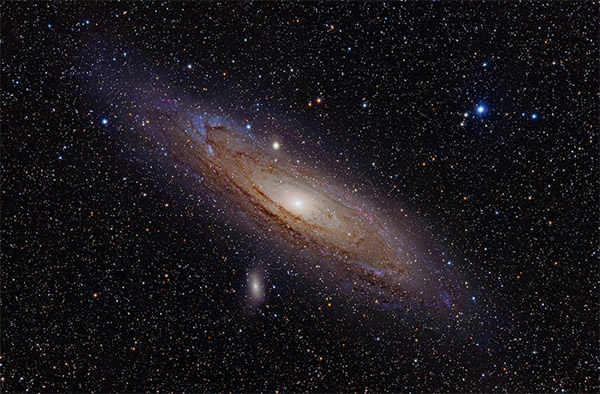The Glitchy Gamma-Ray Burst
Andromeda is a spiral galaxy approximately 2.5 million light-years from the Milky Way.
On Tuesday night, the social web was whipped into a gamma ray burst frenzy. Had neighboring galaxy Andromeda just unleashed one of the most powerful explosions known in the universe? Unfortunately, the event turned out to be a false alarm, but the excitement it generated put the efforts of one space telescope and an entire community of astronomers in the spotlight.
So what happened? The source of the excitement can be narrowed down to a software glitch and a possibly interesting X-ray brightening.
NASA’s Swift telescope orbits Earth and is constantly on the lookout for bright transient events that could be generated by a gamma ray burst (GRB). GRBs are thought to be caused by two colliding neutron stars or by a collapsing massive star. Within seconds, a GRB will generate more energy that our sun will generate in its entire lifetime.
On board Swift is an instrument called the Burst Alert Telescope, or BAT, that will detect a distant flash, alert astronomers on the ground and command Swift’s main X-ray detecting optics to slew in the direction of the flash.
Time is of the essence. The whole process is fast and a community of GRB hunters around the world are on alert around the clock. So when they were notified of a GRB on Tuesday night, all eyes were on the Swift data. But when they realized that Swift had detected the flash in the nearest large galaxy to the Milky Way, there were hopes that this could be a historic moment.
Unfortunately, according to astronomer Phil Evans of the University of Leicester and a member of the real-time Swift data analysis team, it quickly became apparent that the transient brightening wasn’t a new X-ray event in Andromeda, but a known X-ray target.
“Just because the X-ray object was already known about, and was not something likely to go GRB doesn’t mean it’s boring,” Evans said in a blog update. “If the X-ray object was much brighter than normal, then it is almost certainly what triggered the BAT and is scientifically interesting.”
The known X-ray source appears to have triggered the automated software, which alerted the community and the news quickly spread across the social web, particularly Twitter.
Evans pointed out that the Swift team never announced a GRB discovery and that this was merely a preliminary alert that required urgent attention. GRBs are rare and still poorly understood, so immediate action is needed as soon as a candidate event is detected to ensure Swift and other telescopes can quickly measure the GRB’s afterglow that rapidly fades with time.
So in these cases a choice needs to be made: “Do we assume that these preliminary results are correct and chase the object, risking wasting telescope time? Or do we wait until we know for sure, and miss observing a one-in-a-century event?” Evans asks. Obviously, when time is of the essence, you need as many people looking at that patch of sky to avoid missing astromical history unfolding.
But this was one of those times where an X-ray source fooled the BAT software into thinking a GRB was underway.
Although it is a shame that Andromeda isn’t the site of a nearby (but not too nearby) GRB, this is a fine example of science and astronomy at work where cutting edge technology is making real-time observational data available to scientists on the ground. But sometimes on the leading edge of astronomical discovery, there’s the occasional false alarm.(May 29, 2014 04:07 AM ET // by Ian O'Neill)












